He also had a huge influence in transforming Blues music into Rock music, though he never set out to accomplish anything other than playing his own style of music. His “shave and a haircut-two bits” also known as “the Hambone” was the driving pattern that caught the eyes and ears of so many British Invasion bands and American bands of the 1960’s and became a part of their style.
Born in Mississippi and raised by his mother’s cousin, Elias Bates took on her surname, “McDaniel” and used that throughout his life.
 |
| Bo Diddley and Dean Cameron |
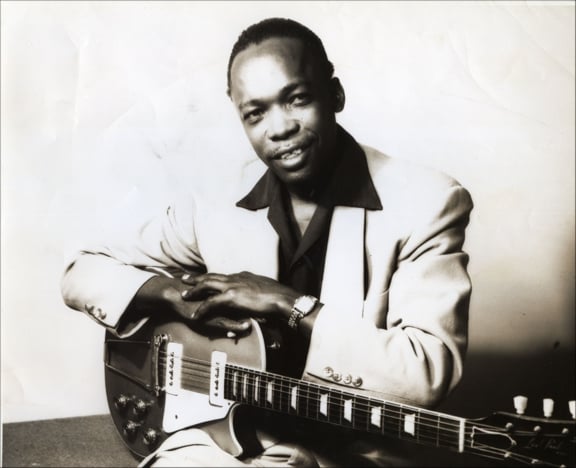 |
| Early photo John Lee Hooker |
The band began to play at some Chicago Blues clubs and started making a name for themselves.
By 1954 he teamed up with harmonica player Billy Boy Arnold, Roosevelt Jackson on bass and drummer Clifton James and recorded some demos at Chess studios including I’m A Man and Bo Diddley. The songs were later re-done with Otis Span on piano and Lester Davenport playing harmonica, Frank Kirkland on drums and his friend Jerome Green playing maracas.
Within a year “Bo Diddley was released and not only went on to become a hit record, but a classic. It was then that McDaniel adopted the stage name Bo Diddley.
The origin of the name is somewhat unclear, as several differing stories and claims exist. Diddley claims that his peers gave him the nickname, which he first suspected to be an insult.
The phrase "bo diddley" was at once Black slang for “absolutely nothing.” But McDaniel states that the name belonged to his adopted mother. And yet another story states the Bo Diddley was the name of a prize fighter.
In any event the we can agree that Bo Diddley was probably derived from a single string homemade instrument called a diddley bow that had its origins in Africa.
The song Bo Diddley became so popular that in 1955 McDaniel and his band were asked to appear on the Ed Sullivan Show. This perhaps made him the first Black performer on the show. Sullivan requested that he sing the popular hit song “Sixteen Tons”, but McDaniel sang Bo Diddley instead.
This infuriated Sullivan and McDaniel was banned from further appearances.
Ironically the Merle Travis song, Sixteen Tons, was one of the featured tunes on the 1960 Album, “Bo Diddley is a Gunslinger. (This was an era when Western TV shows were really big on television.)
He had a string of minor hits through the late 1950’s and ‘60’s In 1963, he starred in a UK concert tour with the Everly Brothers and Little Richard.
The Rolling Stones, still barely known outside London at that time, appeared as a supporting act on the same bill. This helped to further his fame.
Diddley/McDaniel co-wrote another hit song along with his guitarist Jody Williams called “Love Is Strange”which became a chart topper and a classic from Mickey and Sylvia.
Diddley liked to include women in his band. He knew this would be a great visual effect and he gave them nicknames. Norma-Jean Wofford was The Dutchess. Peggy Jones was called Lady Bo and became his lead guitarist.
 |
| Debbie Hastings Bo's bass player |
Diddley wore an ever-present Stetson hat, sometimes bedecked with badges. He also seemed to have a great attire of fancy stage clothes and shoes that enhanced his act.
Diddley continued to perform into the 1970’s era, He even did a concert with the Grateful Dead.
He also lived in Archer Florida, a community near Gainesville. Diddley/McDaniels continued to play music throughout his lifetime until 2007 when he suffered a stroke during a concert.
Two years later and a year after his death, the guitar he played during his final concert was auctioned off for $80,000.
Bo Diddley fashioned homemade guitars from cigar boxes. This was an old folk tradition that gave his signature instrument its distinctive rectangular shape.
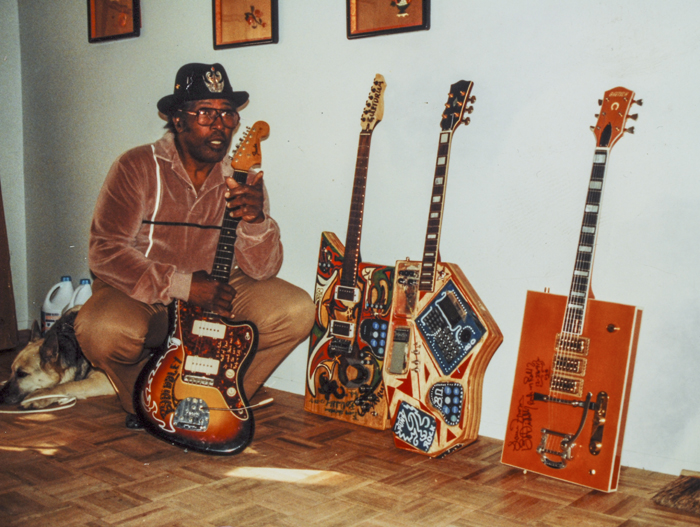 |
| Diddley with some of his gutiar collection |
Before Gretsch began producing Diddley's guitars, he built two dozen or more of this own, famously giving one to Dick Clark after a career-making appearance on American Bandstand.
During his early years Diddley/McDaniel was seen playing a Stewart/Orpheum guitar. This brand was made by a New Jersey factory called Unitedcode. They sourced guitar bodies, necks and parts to a number of manufacturers. The pickups were made by another New Jersey company called Franz. These are exceptional pickups and were used by John D'Angelico on his high-end electric guitars.
Diddley moved on to play a Gretsch Firebird and he really liked this guitar. He approached the designers at Gretsch with his idea of a customized guitar. He wanted a square guitar, like the ones he used to make out of cigar boxes.
He says he made these using a Victrola record player. This device had a magnetic device designed to pick up the sound from the needle. McDaniel would use this to amplify his homemade instrument.
He convinced Gretsch to build his guitar which included DeArmond pickups. In his own words he states that he approached a luthier from White Plains, New York named Guilliano who was a production manager at Gretsch.
He constructed three custom made guitars for McDaniel. These included his square guitar and two Jupiter Thunderbird guitars. As these were custom made instruments, McDaniel says he only authorized one guitar, but believes Gretsch built more. Apparently McDaniel thought the design was copywritten, however that was not the case.
Gretsch designated the square guitar as the G6138, though I have also seen this guitar listed under different serial numbers. Early promo pictures of Diddley carrying the guitar on a motor scooter show it with a red finish and a blue finish, both instruments with twin DeArmond pickups. A 1977 auction site shows, Bo Diddley's own Gretsch square guitar with a somewhat larger body and three DeArmond pickups. The Hard Rock Cafe in St. Louis has a gold finished twin pickup model Gretsch square guitar that belonged to Diddley on display.
He also designed a Gretsch guitar that we best know as The Caddilac Guitar, since it resembled the fins from a late 1950’s Caddilac. However Diddley called it The Jupiter Thunderbird. Gretsch made a couple of these for Diddley. He gave one to ZZ Topps Billy Gibbons. Gibbons has an incredible collection of custom made instruments and decided it would be wrong to tinker with the original, but he had his luthiers redesign the guitar and Gretsch took up the banner. It was released for sale in 2006 as the Gretsch Billy Bo Jupiter Thunderbird, model G6199.
 |
| Tom Holmes Guitar |
So what was the secret of Bo Diddley’s sound? Listening to his guitar you hear a wildly pulsating tremolo.
His guitar was percussive and usually played in an open tuning. With Diddley, it was all about rhythm. His lead lines were usually just open chords played one octave above what he was playing. And he tastefully punctuated his songs with those "lead" lines.
Diddley recalls his tone stemmed largely from his attempts to imitate the sound of a bow on a violin. He also states that he constructed his first tremolo unit out of a clock spring and automobile parts. Of course a good portion of his band’s sound came from the maracas and drums, but his guitar sound was something special.
I’ve heard speculation that it came from the tube driven tremolo in brownfaced Fender amplifiers. And for the most part Diddley did use Fender amplifiers.
I’ve even heard that he used Magnatone amplifiers. However I can find any indication that he utilized Magnatone amps. In my opinion his sound is not similar to that warbling Magnatone vibrato.
However one of the first tremolo units; possibly the first standalone guitar effect was the DeArmond Model 601 Tremolo unit. This was developed in 1946 and available by 1948. And it is documented that one of the first guitarists to use the DeArmond Tremolo was Bo Diddley. In fact he used this on his early Chess recordings.
This unit looks very simplistic with its two knob layout, but in fact its design is somewhat complex.
The unit works by reducing the signal from the guitar several times a second and then building it back up. To achieve this the guitars signal is grounded through a water-based electrolytic hydro-fluid that is located in a canister inside the unit.
Within the canister and insulated from the units body is a pin that is connected to the incoming signal. When the unit is activated, a small motor shakes the canister causing the hydro-fluid to stir and splash against the pin which momentarily grounds out the guitars signal. This produces a liquid watery tone.
Later in his career, Diddley played custom made guitars which had built in effects. One story I have read is from a player in a North Carolina Rock-a-Billy band that had the good fortune to back up Bo Diddley. He states that Bo plugged directly into a rented Fender Twin Reverb amplifer, but his guitar had six or seven knobs on it with LED's to indicated what effect was on.
Listening carefully to Diddley/McDaniel I can also hear some tube distortion and definitely some echo.







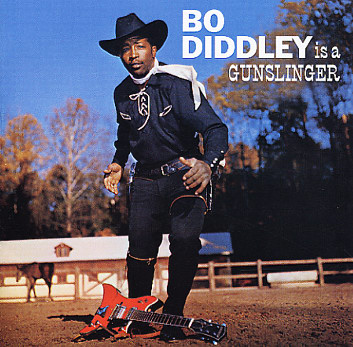

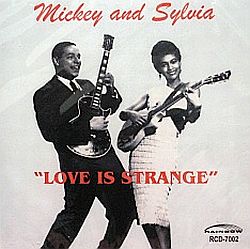




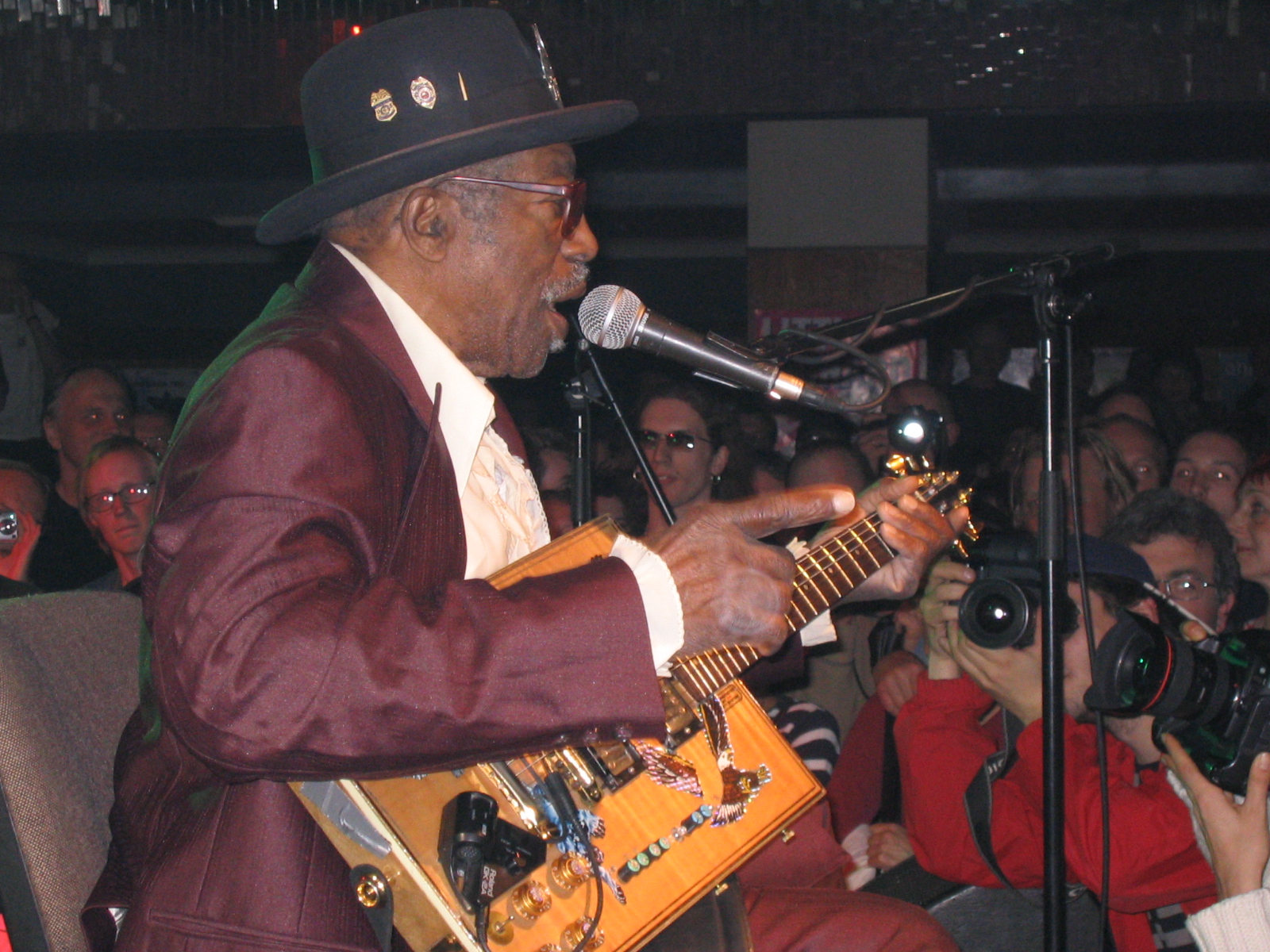








Tidak ada komentar:
Posting Komentar